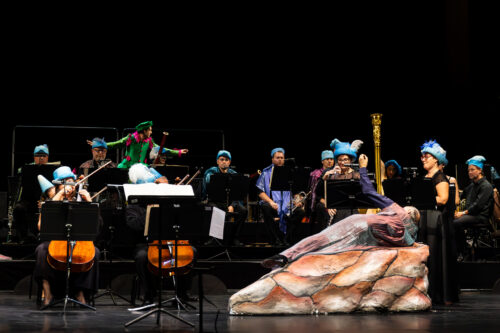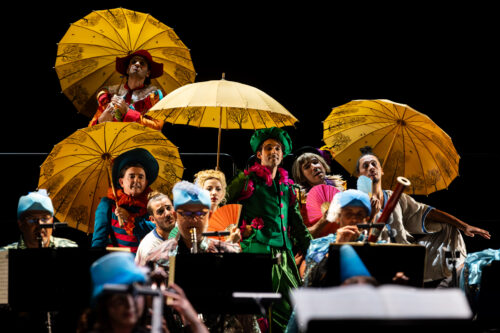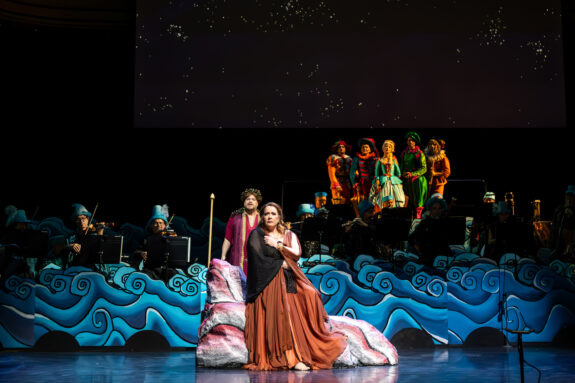 Hungary R. Strauss: Le Bourgeois gentilhomme (orchestral suite) Op.60-IIIa, Ariadne auf Naxos: Soloists, Budapest Festival Orchestra / Iván Fischer (conductor), Müpa Budapest, 8.9.2024. (AK)
Hungary R. Strauss: Le Bourgeois gentilhomme (orchestral suite) Op.60-IIIa, Ariadne auf Naxos: Soloists, Budapest Festival Orchestra / Iván Fischer (conductor), Müpa Budapest, 8.9.2024. (AK)
Cast:
Bacchus – Andrew Staples
Zerbinetta – Anna-Lena Elbert
Ariadne – Emily Magee
Harlequin – Gurgen Baveyan
Scaramuccio – Stuart Patterson
Truffaldin – Daniel Noyola
Brighella – Juan de Dios Mateos
Naiad –Samantha Gaul
Dryad – Olivia Vermeulen
Echo – Mirella Hagen
Actors – Utka Gavuzzo, Camilo Daouk
Production:
Director – Iván Fischer
Co-director and choreography – Chiara D’Anna
Stage design – Andrea Tocchio
Costumes – Anna Biagiotti
Lighting – Tamás Bányai
Animation – Flaviano Pizzardi
Richard Strauss’s Ariadne auf Naxos is presented in an unusual and highly innovative form by the Iván Fischer Opera Company and Fischer’s Budapest Festival Orchestra. On paper a co-production by three organisations – Spoleto Festival dei Due Mondi, Müpa Budapest and Vicenza Opera Festival – in reality the production is Iván Fischer’s brainchild which reached Budapest after two performances in Spoleto in June 2024 and the three Budapest performances will be followed by further presentations at Vicenza on 24th, 26th and 27th October 2024.
Strauss’s Ariadne auf Naxos had a chequered history. Initially Strauss’s librettist Hugo von Hofmannsthal shortened Molière’s five-act opera-ballet Le Bourgeois Gentilhomme – premiered with Lully’s music in 1670 – while Strauss wrote new accidental music to the shortened play and composed a brand-new opera (Ariadne in Naxos) to add to it. This double-take turned out to be too long for audiences, the premier in 1912 was a total flop. Subsequently Hofmannsthal and Strauss abandoned the Molière play, wrote a new piece to replace it and Strauss slightly recomposed the opera. This new version was premiered with success in 1916; this is how most of us still know Ariadne auf Naxos: with the Prologue and the Opera. From 1920, the accidental music composed by Strauss to Molière’s play has lived on as Le Bourgeois gentilhomme orchestral suite Op.60, appearing on concert stages from time to time.
For his Ariadne auf Naxos production Fischer abandoned the 1916 Prologue and returned to the Op.60 Le Bourgeois gentilhomme orchestral suite. In this music Strauss pays homage to Lully as well as to baroque style in general. Strauss takes on board the Molière story, aiming to depict Monsieur Jourdain’s trials and errors in his pitiful and unsuccessful pursuit to become a member of aristocratic nobility. The nine movements of Strauss’s orchestral suite refer to Monsieur Jourdain’s encounters with the tailor, fencing master and so on.
However, Fischer’s production leaves aside the Molière plot and opts to extend the duality in the opera, which is opera seria versus opera buffa, for both parts of the evening. Furthermore, Fischer unifies the genre of commedia dell’arte with opera, as well as performance practices then and now.
In the first part, that is with the Le Bourgeois gentilhomme music, Fischer’s concept is to show a commedia dell’arte company preparing for an opera performance. This makes sense as in the opera the commedia dell’arte genre appears alongside the serious opera. Fischer involves all on the stage, himself including, in the comic comings and goings. To me the highly entertaining staging was more a parody of an orchestra/opera rehearsal than the presentation of a troublesome opera rehearsal.
It is utterly astonishing what Fischer can do on stage (on the top of creating great musical performances). It is also amazing what he can get from his performers.
During the performance of Le Bourgeois gentilhomme two actors present juggling acts but they also take part in the dramatic presentation. Members of the orchestra – on the stage throughout the evening – double as musicians and actors: several of them play their solos from memory while often moving around the stage. The concert master (Daniel Bard) may be used to solo performances from memory but here he moves, acts and gets dressed in a shiny coat while playing his extensive solo in the fourth movement (and later in shorter solos) superbly.
The singers performing the commedia dell’arte parts in the opera are actors in Le Bourgeois gentilhomme, their characters (that is Zerbinetta, Harlequin, Scaramuccio, Truffaldin and Brighella) provide much of the action and parody. They mime, they dance, and at times, they present highly skilled acrobatic dance moves. They put jolly hats on all musicians and shiny coats on the orchestra leader as well as on the conductor while the music is being played as if there was no distraction. And, together with the two actors, they also shift the light scenery when needed.

Fischer is fully involved in the fun of acting. At one point he is lifted by the two actors, is carried horizontally for a few steps and then he is lowered down to lie fully covered on a low sofa during which time Fischer continues to conduct first just with one hand poking out of the cover but soon followed by a whole arm. There are a few bars when the orchestra plays without any conducting. For his solo in the last movement, the solo cellist sits on Fischer – although hopefully this is a visual trick, not the reality – while playing from memory to high standard. And, to complete all imaginable stage skills, Fischer also jumps and dances at appropriate dramatic moments.
There is no funny business in the actual opera, other than as specified by Hofmannsthal and Strauss. Nevertheless, Fischer and his orchestra leader Daniel Bard continue to wear their shiny coats, some of the orchestra members continue to wear their funny hats. Presumably this is a reference to the first half of the evening which is meant to present a rehearsal for Ariadne auf Naxos.
At the performance I attended the musical delivery was exemplary. Fischer conducted with loving care for all details and held together the complicated score with admirable skills.

All singers were of top quality and offered high quality performances. Anna-Lena Elbert (Zerbinetta) is a virtuoso performer in all dimensions, her brilliant singing is matched by her admirable physical abilities and dramatic insight.
Emily Magee is a noble Ariadne although for her I would have wished slightly more space on stage. It is true that Ariadne spends most of the time depressed and apparently hiding from the world but, arguably, the lack of stage space made her more static than the role may require.
The three ladies presenting Naiad (Samantha Gaul), Dryad (Olivia Vermeulen) and Echo (Mirella Hagen) produced particularly sensitive singing and while not a Heldentenor (which is the voice often employed in the part), Andrew Staples presented a fully credible and highly musical Bacchus.
Fischer assembled excellent co-workers. His co-director and choreographer Chiara D’Anna is an expert in performance practice of the commedia dell’arte genre. Anna Biagiotti’s costumes were beautiful (I loved those of the three ladies in particular) as well as historically informed for Zerbinetta and her troupe. Andrea Tocchio’s stage design managed to fool us into believing that we were in Naxos; not an easy task on a concert stage packed with 37 orchestra players, nine singers and two actors. Three cheers also for Tamás Bányai’s eye-pleasing lighting and Flaviano Pizzardi’s video depicting the sea as part of the design.
All members of the production team seem to have delivered in line with Fischer’s concept. How often does such co-operation happen in opera houses?
The production moves to the Vicenza Opera Festival where it will be shown in the Olympic Theatre (apparently the oldest covered theatre in the world) on 24th, 26th and 27th October 2024. Do not miss it!
Agnes Kory
Featured Image: Iván Fischer’s Ariadne auf Naxos: featuring Andrew Staples (Bacchus) and Emily Magee (Ariadne) © Éva Juhász
